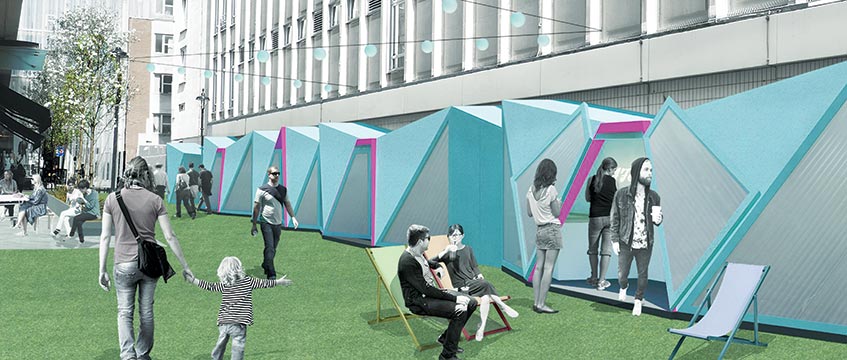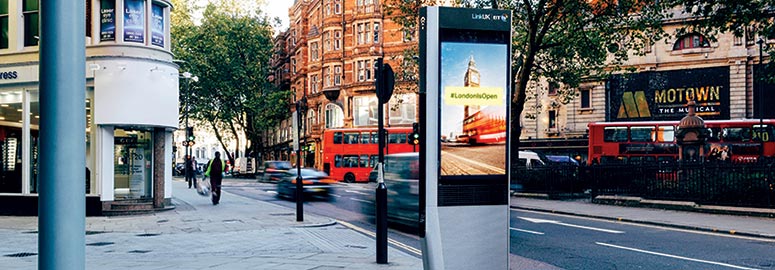There is a little street, just off one of the busiest streets in the world, which is aiming to become the smartest street on the planet. Its name? Bird Street.
Even as a Londoner or a regular on Oxford Street, you may never have wandered down Bird Street. It is bland, uninspiring and definitely not smart.
Not is – was.
Late last year, the New West End Company drew up plans to turn this short, unloved, largely blocked-off street into an oasis for visitors to Oxford Street, providing them with the opportunity to take time out from the hustle and bustle of the country’s busiest shopping street. And NWEC wants to do that with smart and green technologies.
Using cash from Transport for London’s Future Streets Incubator, Bird Street will become a pilot for what NWEC chief executive Jace Tyrrell hopes will become the future of the Oxford Street estate. It is a plan that he hopes will transform people’s experience of the world-famous shopping street into more than just that linear traipse up and down Oxford Street. He wants tourists and Londoners alike to discover the hidden gems north and south off Oxford Street and all they have to offer.
Transformation
From 29 June, for six months, Bird Street will be completely transformed. Pop-up shops designed to look like origami birds will feature hot new names in fashion, tech and sustainability, while evergreen grass will be laid on the ground and a 6m living green wall installed.
But what will really make Bird Street the smartest street in the world is the tech.
Pavegen tiles will be laid to not only turn visitors footsteps into energy, but also to collect data, while air-cleaning paint and filters will provide respite from London’s increasing levels of pollution. Pollution levels on Oxford Street breached the legal limit for a whole year after just four days in 2015.
The tiles will turn the kinetic energy produced by people walking over them into off-grid energy that can either then be stored in lithium batteries or used to power nearby electronics instantly.
“We are going to be powering the lights on the street and because it is Bird Street, powering birdsong,” says Pavegen founder and chief executive Laurence Kemball-Cook. “So, as you walk along at night not only will you have the lights but you will also be able to hear some bird noise.”
While Bird Street will be one of the most high-profile destinations for a Pavegen installation – alongside the array of tiles outside the White House – it is just the first step in what Kemball-Cook hopes will be a giant leap in the smartification of cities around the world.
“Our aim is to have 1m tiles in every city, so that each has an off-grid, decentralised supply run through the energy of people’s steps,” he says.
Pavegen believes that 270 tiles in an area of 80 sq m (861 sq ft) will generate 1kW of power from 120 pedestrians. Over an hour, this will generate enough energy to enable you to watch six episodes of the latest series of Game of Thrones on your plasma TV or type away on your laptop for as much as 20 hours.
Data matters
But the tiles are not just about power. As with all things smart, it is the data that really matters.
Tyrrell says NWEC will measure everything on the street and use that data to see how it can improve experiences across the whole of Oxford Street. Footfall data from the tiles will not only provide information on how many people are using Bird Street but at what time.
The BID is looking at a number of different streets in the West End to see how to power them renewably and transform them into more pedestrian-friendly retail destinations. A big part of that transformation is improving air quality.
The Bird Street project will employ “gas phase advance oxidation units”, to be installed within temporary seating structures. The units, provided and run by Piccadilly-based start-up Airlabs, suck up exhaust fume particles and other pollutants and pump out fresh air.
Street furniture on the new and improved Bird Street will also be coated with paint from Airlite, a substance that reduces pollutants in the air, eliminates bacteria and reduces energy consumption.
“Customers are demanding better air quality,” says Tyrrell. “In the future they will be walking around with their smartphones measuring it.”
And it is people’s increasing use of smartphones for everything they do that has informed the final element of the smartification of Bird Street.
NWEC has teamed up with BT to install its new LinkUK kiosks on the street. One kiosk will replace five, unused, outdated, space-hogging telephone boxes and will provide free WiFi and wayfinding services for customers. The kiosks have already been used with great success across New York City, with more than 35m sessions logged.
Labelled the next generation of payphones, the kiosks offer free ultrafast WiFi with speeds of up to 1gbps to users within a designated range, USB charging points and touch-screen interfaces for wayfinding and local services. They also feature sensors to capture real-time data on the local environment, such as air and noise pollution, temperature and traffic conditions.
While NWEC’s Bird Street experiment may be only small, its impact could be massive. Using the lessons learnt from the six-month pilot, investors, developers, planners and occupiers alike should be able to create spaces that customers can use efficiently, effectively, sustainably and – ultimately – profitably.
Not just a smart street, but a smart move.
Smart measures
Pavegen: A simple floor tile that is made clever by the people who walk over it. Power is generated when the tile is compressed. It uses the piezoelectric effect – the ability of certain materials to generate an electrical current when compressed – as well as induction, through numerous tiny copper coils and magnets, to create a charge. The tile is also Bluetooth- and WiFi-enabled to provide an analysis of consumer patterns by tracking footfall and heat mapping. www.pavegen.com
Airlabs: Particles are trapped by a tailored filtration system before gas pollutants, such as NO2, are absorbed by specialist media within its units. The system removes more than 95% of nitrogen dioxide from the atmosphere. www.airlabs.com
Airlite: A 100% natural technology developed to be coated on products such as paint to suck toxins out of the air. Reduces the amount of air pollutants by 90% and eliminates 99.9% of bacteria. It also blocks the growth of mold and microbes and eliminates odour. www.airlite.com
LinkUK: The new generation of phoneboxes from BT. WiFi hotspot, USB charging point, marketing and wayfinding tool that also collects data from its surroundings. www.linkuk.uk
To send feedback, e-mail Samantha.McClary@egi.co.uk or tweet @Samanthamcclary or @estatesgazette












